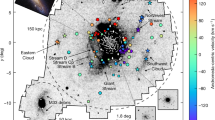Abstract
Mass accretion is the key factor for evolution of galaxies. It can occur through secular evolution, when gas in the outer parts is driven inwards by dynamical instabilities, such as spirals or bars. This secular evolution proceeds very slowly when spontaneous, and can be accelerated when triggered by companions. Accretion can also occur directly through merging of small companions, or more violent interaction and coalescence. We discuss the relative importance of both processes, their time-scale and frequency along a Hubble time. Signatures of both processes can be found in the Milky Way. It is however likely that our Galaxy had already gathered the bulk of its mass about 8–10 Gyr ago, as is expected in hierarchical galaxy formation scenarios.
Similar content being viewed by others
References
Binney, J.: 1992, Annu. Rev. Astron. Astrophys. 30, 51.
Bond, J.R., Kaiser, N., Cole, S. and Efstathiou, G.: 1991, Astrophys. J. 379, 440.
Bothun, G., Impey, C. and McGaugh, S.: 1997, Publ. Astron. Soc. Pacific 109, 745.
Bottema, R.: 1993, Astron. Astrophys. 275, 16.
Blitz, L., Spergel, D.N., Teuben, P.J., et al.: 1998, Astrophys. J., in press (astro-ph/9803251).
Carlberg, R.G.: 1990a, Astrophys. J. 350, 505.
Carlberg, R.G.: 1990b, Astrophys. J. 359, L1.
Carlberg, R.G.: 1991, Astrophys. J. 375, 429.
Governato, F., Gardner, J.P., Stadel, J., et al.: 1998, astro-ph/9710140.
Gunn, J.E.: 1987, in: S.M. Faber (ed.), Nearly Normal Galaxies, Springer, New York, p. 459.
Ibata, R.A., Gilmore, G. and Irwin, M.J.: 1994, Nature 370, 194.
Johnston, K.V.: 1998, Astrophys. J. 495, 297.
Kennicutt, R.C.: 1989, Astrophys. J. 344, 685.
Lacey, C. and Cole, S.: 1993, Mon. Not. R. Astron. Soc. 262, 627.
Lacey, C. and Cole, S.: 1994, Mon. Not. R. Astron. Soc. 271, 676.
Lavery, R., Seitzer, P., Walker, A.R., et al.: 1996, Astrophys. J. 467, L1.
Lin, D.N.C. and Pringle, J.E.: 1987, Mon. Not. R. Astron. Soc. 225, 607.
Lin, D.N.C. and Lynden-Bell, D.: 1977, Mon. Not. R. Astron. Soc. 181, 59.
Majewski, S.R.: 1993, Annu. Rev. Astron. Astrophys. 31, 575.
Mo, H.J., Mao, S. and White, S.D.M.: 1998, Mon. Not. R. Astron. Soc. 295, 319.
Richter, O-G. and Sancisi, R.: 1994, Astron. Astrophys. 290, L9.
Schweizer, F. and Seitzer, P.: 1992, Astron. J. 104, 1039.
Searle, L. and Zinn, R.: 1978, Astrophys. J. 225, 357.
Toomre, A.: 1977, in: B.M. Tinsley and R.B. Larson (eds.), The Evolution of Galaxies and Stellar Populations, Yale Univ. Obs., New Haven, p. 401.
Toth, G. and Ostriker, J.P.: 1992, Astrophys. J. 389, 5.
Tsujimoto, T., Yoshii, Y., Nomoto, K. and Shigeyama, T.: 1995, Astron. Astrophys. 302, 704.
Press, W.H. and Schechter, P.: 1974, Astrophys. J. 187, 425.
Putman, M.E., et al.: 1998, Nature 394, 752.
Quinn, P.J., Hernquist, L. and Fullagar, D.P.: 1993, Astrophys. J. 403, 74.
Reshetnikov, V. and Combes, F.: 1997, Astron. Astrophys. 324, 80.
Sarajedini, A., Geisler, D., Harding, P. and Schommer, R.: 1998, Astrophys. J., in press (astroph/ 9809275).
Unavane, M., Wyse, R.F.G. and Gilmore, G.: 1996, Mon. Not. R. Astron. Soc. 278, 727.
Velazquez, H. and White, S.D.M.: 1998, Mon. Not. R. Astron. Soc., preprint (astro-ph/9809412).
Yee, H.K.C. and Ellingson, E.: 1995, Astrophys. J. 445, 37.
Zhao, H.: 1998, Mon. Not. R. Astron. Soc. 294, 139.
Zhao, H.: 1998, Astrophys. J. 500, L149.
Zinn, R.: 1993, in: H. Graeme, H. Smith and Jean P. Brodie (eds.), The Globular Cluster-Galaxy Connection, ASP Series, p. 38.
Author information
Authors and Affiliations
Rights and permissions
About this article
Cite this article
Combes, F. Time-Scale for Accretion of Matter. Astrophysics and Space Science 265, 417–424 (1999). https://doi.org/10.1023/A:1002138027767
Issue Date:
DOI: https://doi.org/10.1023/A:1002138027767




